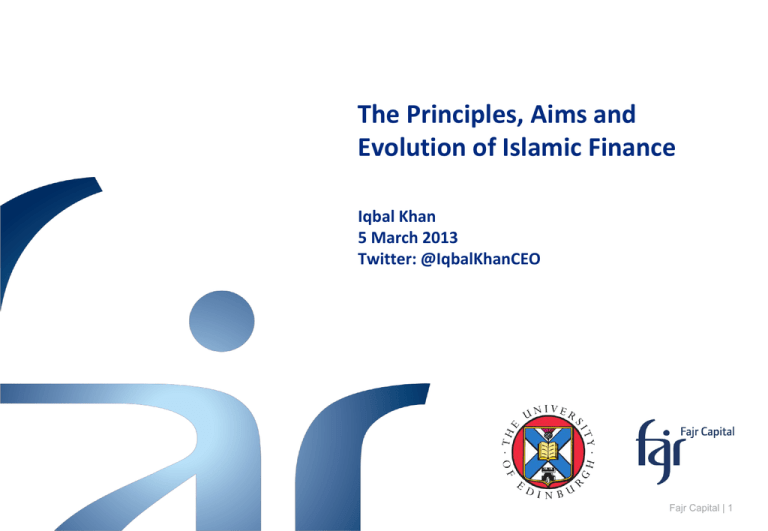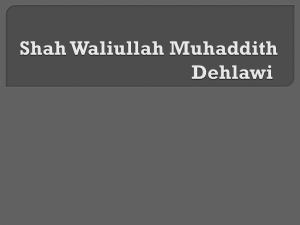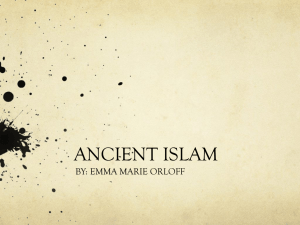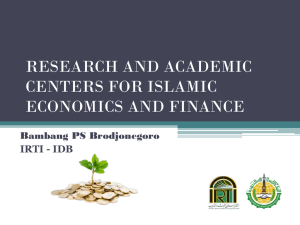accompanying Powerpoint
advertisement

The Principles, Aims and Evolution of Islamic Finance Iqbal Khan 5 March 2013 Twitter: @IqbalKhanCEO Fajr Capital | 1 The importance of ethical finance is underpinned in the monotheistic scriptures • Being in debt is equivalent to servitude because of the immense burden to repay. Hence, “The rich rule over the poor and the borrower is slave of the lender” (Proverbs 22:7). • "The first question an individual is asked in the afterlife at the final judgment is: “Did you conduct your business affairs honestly?” (Babylonian Talmud, Shabbos 31a) • “However plentiful usury may look from the outside, its end is want and ignominy” (Hadith) CHRISTIANITY JUDAISM ISLAM Islamic Finance is a continuation of the principles of CSR, ethics and fairness in the Abrahamic faith Fajr Capital | 2 Islamic Finance principles consist of core basic tenants 1 If something is immoral, one cannot profit from it 2 To share reward, one must also share risk 3 One cannot sell what one does not own 4 In any transaction, one must clearly stipulate what he or she is buying or selling and what price is being paid Removing speculation and creating value-enhancing and sustainable activity Fajr Capital | 3 Islamic Finance is the outcome of CSR derived from religion and applied to banking Accountability to God Ethical profits “More-than-profit” mentality (rather than “profits-atany-costs”) Business ethics Shari`a “code of ethics” Islamic Finance is capitalism with a moral compass Fajr Capital | 4 The industry has developed a comprehensive product offering over its young history Development of industry − − Development of theoretical framework Muslim-majority nation independence 60s − − Egypt and Malaysia pioneering institutions Establishment of OIC (1969) 70s − − Islamic Development Bank (1974) and DIB One country-one bank setup 80s − − Advancement of Islamic products Full “Islamization” of Iran, Pakistan and Sudan 90s − Entry of global institutions e.g. HSBC Amanah 00s − − Tipping point reached in some markets Development of industry-building institutions 1950s Evolving richness in products structured products Debt issues insurance private equity 2000s 1970s 1990s 1980s project finance equity syndications structured and trade finance Industry has near like-for-like parity with conventional offering Fajr Capital | 5 In all, the Islamic finance industry is developing a global reach… Growth Engine Awakening Ripe for Growth Future Markets Source: Standard and Poor’s “The Globalization of Islamic Finance” Fajr Capital | 6 The development of the Islamic finance industry has been fuelled by pioneering institutions and industry building organisations Fajr Capital | 7 Growth and drive is being led by customer demand Government driven Sudan Islamic Finance was not established by a royal decree or a presidential announcement, but it was the will of the people which created the industry. Iran Malaysia Growth in the GCC Islamic banking markets are primarily driven by customer demand Bahrain Pakistan Brunei UK Singapore Malaysia presents a near ideal regulatory and market-driven model for Islamic business Kuwait UAE USA Japan China Bangladesh Qatar Sri Lanka Indonesia Saudi Arabia Egypt Source: Central Bank, Reports, industry estimates Turkey Key: Bubbles indicate illustrative size of Islamic banking assets Market driven Fajr Capital | 8 The Islamic finance ecosystem is growing: Total Islamic finance assets may surpass $1.8 trillion in 2013 Top 20 Islamic banks make up 55% of the total Islamic banking assets and are concentrated in 7 countries, including GCC, Malaysia and Turkey. 13 Islamic banks have an equity base of more than $1 billion. Building regional institutions and participating in larger transactions requires the industry to scale up. Financing Growth - CAGR, 2008-11 (%) Saudi Arabia Kuwait Saudi Arabia Qatar UAE UAE Qatar Bahrain Qatar Malaysia Saudi Arabia Turkey UAE Kuwait Saudi Arabia Turkey Malaysia Kuwait Kuwait UAE Bank's Home Market Islamic finance continues to grow at an exponential pace. Higher growth in personal financing assets is made up from a number of factors: pricing differential has been reduced or eliminated, customers are more accepting of Islamic finance, and the industry’s distribution capability has improved immensely. 35 30 25 20 15 10 5 0 Corporate 0 1000 2000 3000 4000 5000 6000 Equity US $m Source: Ernst and Young – The World Islamic Banking Competitiveness Report 7000 8000 9000 Government Personal Conventional Real Estate Services Islamic Fajr Capital | 9 Some of the pioneers of the Islamic finance industry SHARI’A SCHOLAR Sheikh Ibn Baaz (1910 – 1999) ENTREPRENEUR ACADEMIC REGULATOR Sheikh Saleh Kamel Royal Professor Lord Eddie George Ungku Abdul Aziz (1938 – 2009 ) (1941 – ) (1922 – ) PRACTITIONER Sir John Bond (1941 – ) Fajr Capital | 10 Mountaineering Analogy: The Islamic Finance industry has come a long way since the days of its pioneers, but it still has a long way to go… Creating role model institutions which facilitate the demonstration effect. Democratizing wealth and ensuring stability. Beacon House Fortifying and strengthening the industry’s foundations. A globally recognised one trillion dollar + industry. Laying the Foundations 150% increase over the last five years. Exponential growth in core markets i.e. Middle East and Malaysia. The evolving political and economic paradigm will drive our industry forward Fajr Capital | 11 Today’s interconnected and dynamic world is presenting a unique opportunity for Islamic finance to prosper THE GREAT RECESSION The global economic crisis – sparked by the bursting of the U.S. housing bubble and fuelled by various systemic imbalances. The effects of the crisis is now being felt by those at the grassroots, and is leading to a political and economic paradigm shift. OCCUPY MOVEMENTS ARAB AWAKENING The “Occupy Movements” have highlighted grassroots support for concrete reforms in the financial services sector. The movement led to protests and occupations in over 80 countries and across every continent except Antractica. The Arab Awakening was driven by the young people facing dire socioeconomic conditions, with access to social media and a hunger for change. The uprisings led to regime changes in Tunisia, Egypt, Libya – and protests in Bahrain and Syria, amongst others. Fajr Capital | 12 The current global economic crises highlight the need for a valuebased approach to financial services 1 Financial Institutions Need for savings and investment orientation to replace consumption and credit culture 2 4 Policy Implications Global Markets Impact points Differentiation between deposit-taking institutions and investment managers Dangers of opaque sale of debt now shown to be evident 3 Real Economy Stronger links needed between banking and real economy investment Material crisis requires moral solutions Fajr Capital | 13 How Scotland can capture the Islamic finance opportunity 1 POLITICAL ENABLEMENT 2 ATTRACTING ISLAMIC FUNDS 3 RESEARCH AND INNOVATION 4 THE PEOPLE PARADIGM 5 CREATING SUSTAINABLE GROWTH • Regulatory and public sector support to make Scotland a ‘hub’ for the Islamic finance industry. • Trade and Investment engagement with high-growth OIC markets to attract funding for projects i.e. Sukuk model. • Creation of a Centre of Excellence to provide much-needed research and analysis to support the industry’s growth. • Islamic finance academic programmes at Scottish universities to attract domestic and international students. • Boosting job creation and economic prosperity by enabling Scottish companies to expand in Muslim-majority markets. Fajr Capital | 14 Martin Luther King, Jr. (1929-1968) “Through our scientific genius we have made of the world a neighborhood; now through our moral and spiritual genius we must make of it a brotherhood.” Fajr Capital | 15 Fajr Capital | 16








